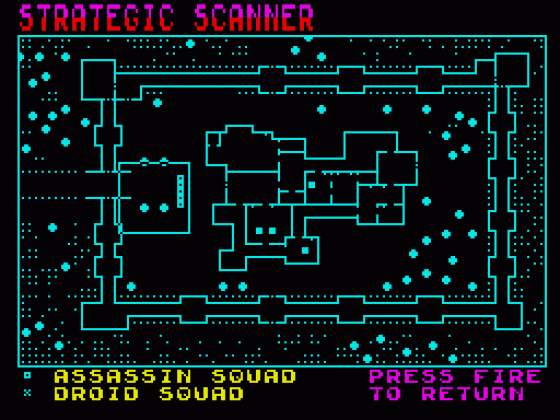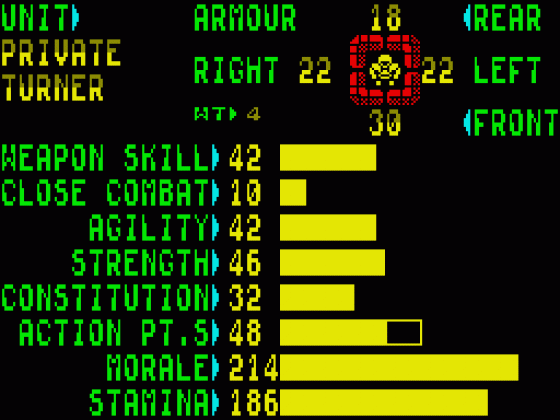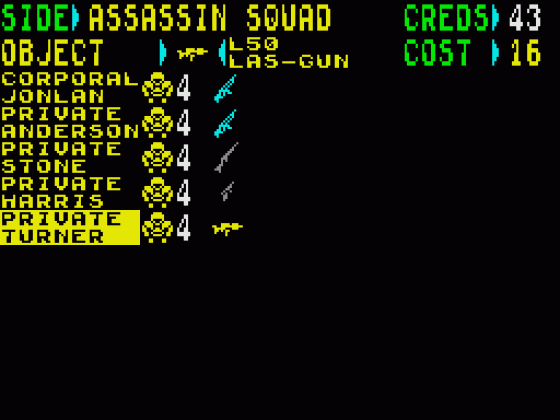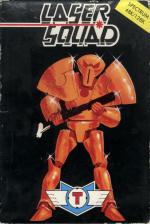
Crash
 1st December 1988
1st December 1988
Author: Philippa Irving
Publisher: Target Games
Machine: Spectrum 48K/128K
Published in Crash #59
Laser Squad
Far back in the mists of time Julian Gollop wrote a superb strategy game called Rebelstar Raiders. Published by a small company it remained fairly obscure until Firebird released it on budget as Rebelstar. Now the game has resurfaced as the centrepiece of Gollop's new software - Target Games. Updated and thoroughly redesigned as Laser Squad the obvious question is, has Gollop produced another classic?
First impressions are sadly disappointing due to lack of background detail. The Laser Squad of the title seem to be a freelance rebel sharpshooting team, here involved in three scenarios simulating individual scenarios for one or two players. It's a pity more work wasn't put into characterizing the squad members as this would obviously add to the atmosphere. Another drawback is that some of features described in the manual aren't used by the scenarios included, but are instead promised for expansion kits. In my experience expansion kits are almost invariably exercises in wishful thinking on the part of the software house.
Nevertheless the game seems well equipped for such kits, with the scenarios provided being loaded individually after the main program. The scenarios are The Assassins, Moonbase Assault and Rescue From The Mines. The first scenario is the smallest and shortest, and is the one that most players will begin with. But not necessarily the easiest.

In each scenario the player controls a team of six or so individual units. Each trooper has his own set of characteristics which, although not listed in the rulebook, can be examined once into the game itself. A pool of credits is available to be spent equipping each trooper.
Equipment includes four types of armour, offering varying protection for the front, back and sides at a proportionately greater cost - obviously reducing credit points for weaponry. In practice I found that even level four armour offers scant resistance to the enemy lasers, with troopers almost always perishing after a second hit.
Economizing on armour leaves more money for the far more interesting, and effective task of weapons selection. Included here are a rocket launcher, dagger, grenade, explosive and six different types of gun. The characteristics of each type of weapon are set out in a rulebook table complex enough to be bewildering. In addition to the predictable damage factor, weapons have a different percentage chance of hitting the target at a distance and at close combat, a weight (and therefore an encumbrance value), and a skill factor to determine how well an inexperienced user will handle it. The weapons vary in cost too, in rough proportion to their firepower - but this should by no means be the only consideration when matching weapons with individual. For example someone with a high firing skill could make excellent use of a sniper rifle, whereas a novice is probably better off with a costly heavy laser. The most deadly weapon on the list is the explosive, closely followed by the rocket launcher.

Having suitably kitted out your squad you can the deploy them via some nicely presented, idiot-proof selection screens. Ingame graphics are similarly attractive, complete with building, trees and so on. These are shown in a kind of squashed overhead view 3-D which scrolls a character block at a time. A panel beside this main display identifies everything under the cursor in case there should be any doubt about it. 'Scanner screen - 'potted plant' - comfy chair' - even 'loo'. These items are merely for decoration, and occasionally for blowing up. It would add an arcade adventure element to the game if the player's units could interact with the landscape in some more positive way.
The player can deploy his six(ish) units on a selection of squares specified by the computer. Although a fairly wide area is offered it invariably makes sense to station the men as near to the entrance of the target building as possible.
In the first scenario, The Assassins, this is the private home of a mad scientist, Sterner Regnix, who has been treating his research team to mind-manipulating drugs in an effort to make them work better. The Laser Squad, supposedly a group of ex-employees, have taken it upon themselves to stop this by assassinating the mad scientist. The player's task is to use his units to do this, first finding Sterner and disposing of any robotic bodyguards encountered on the way.

Play is menu-driven, with a series of options available in different modes. From an uncommitted map position the player can call up a strategic version of the map, which shows the whole landscape in diagrammatic form and the position of friendly and visible enemy units. This facility becomes very useful in the later, larger scenarios, when it is quite difficult to keep track of the branching corridors.
Units can be selected in turn, triggering another menu. (This is where, for the first time, the player has the opportunity to examine the individual characteristics of the men.) Some, like weapon skill, are constant. Others, like morale and stamina, decrease with time and circumstance.
Every action a unit performs, whether moving, opening a door or firing a weapon, uses up action points. How many depends on the type of action, and also how much weight the trooper is burdened with. In fact, even turning to face in another direction costs an AP, and it is irritatingly easy to waste points by spinning around in the wrong direction. Unfortunately there's no facility to take back such moves. When the unit is facing the right direction, it can be moved forward in a reasonably simple manner. Closed doors have to be opened - occasionally, they have to be unlocked. In the case of the third scenario, Rescue From The Mines, they have to be blasted away with a rocket launcher.

Nothing exciting happens until a unit runs into the line-of-sight of an enemy, and by the time this happens it is often too low in action points to fire. This system tends to put the attacker at an inherent disadvantage - which is my excuse for getting massacred with consistency on the easiest level.
Combat is elaborate but slick. Most fighting is done long-range. Depending on the weapon, a unit can choose between three types of fire - auto, snap-shot and aim - arid can even use the weapon as a missile. Autofire is inaccurate and therefore generally ineffective, but it doesn't cost many action points. Aim fire has a far greater chance of hitting its target, but it takes precious time. Such firepower can be aimed at anything, including walls, doors and items of furniture. The results can be spectacular. In the second scenario, one corridor was blocked by a gas canister. I fired at it and duly destroyed it. Unfortunately, the firing unit was standing too close, and the explosion blew up everything within a medium radius.
This is all made visually exciting by flashing fire-beams, colourful explosions and crumpled pieces of scenery when the beam goes wide of its intended target. It is satisfying to watch, but in my case the outcome was all too often settled by a couple of shots by a robot sprung from hiding.

The second scenario, Moonbase Assault, presents the player with a more elaborate map, a larger team, and a greater number of opponents to destroy. Rescue from the Mines has a different flavour, for the [task involves] releasing three prisoners from their cells in a labyrinthine mine complex and escaping with them to the lift shaft rather than killing the enemy.
The rulebook explains the basics of play well, then goes into full details of the working of the game's system. It's a pity there isn't any attempt to link the scenarios together with a more detailed background, but maybe you could write your own.
After a few turns of practice, play is swift and smooth. The menu system works very well. There is a one- or two-player option, though no choice of sides in the one-player version, and the three scenarios offer several levels of play and a sufficient variety of setting and tactics to be genuinely worthwhile. The original concept of Rebelstar was elegant and addictive, and Laser Squad takes it much further without losing any of its playability. Definitely recommended.













